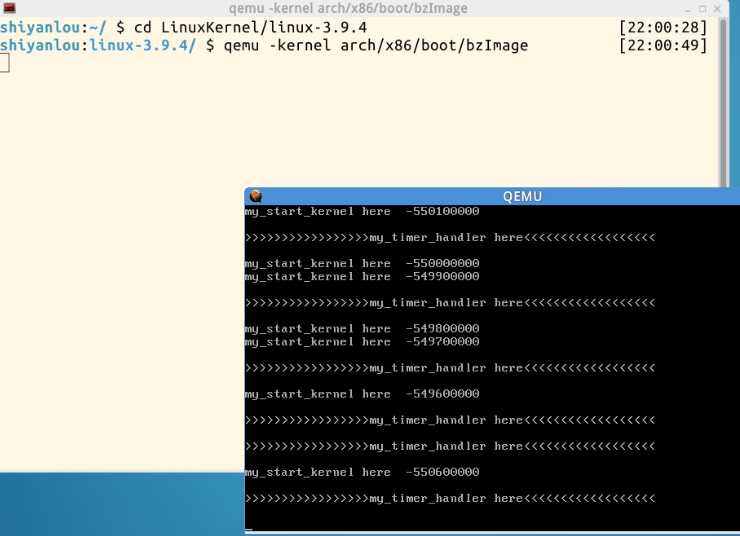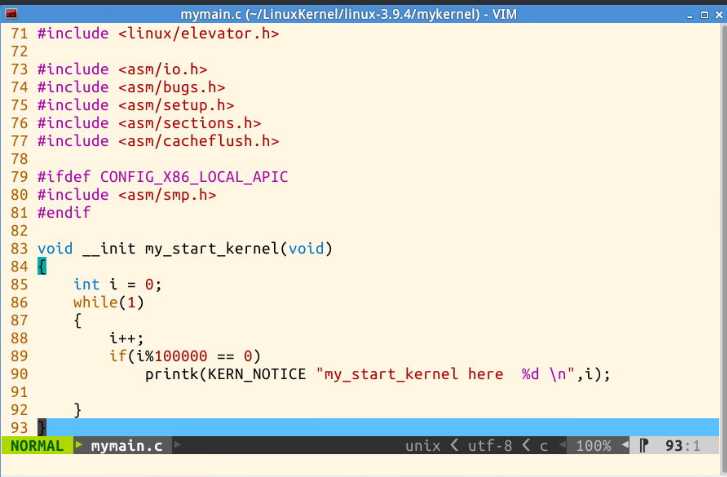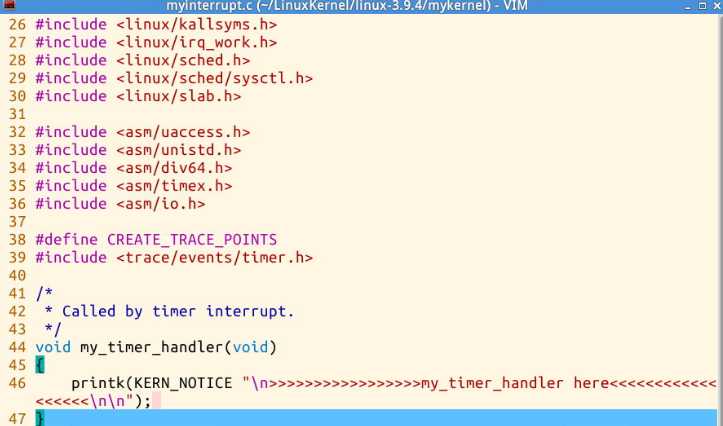标签:
操作系统是如何工作的
攥写人:杨光 学号:20135233
( *原创作品转载请注明出处*)
( 学习课程:《Linux内核分析》MOOC课程http://mooc.study.163.com/course/USTC-1000029000 )
知识总结:
***计算机工作的三个法宝
存储程序计算机、中断机制、堆栈
***堆栈的作用
***堆栈用到的寄存器
***EIP寄存器
cs:eip:总是指向下一条的指令地址
顺序执行:总是指向地址连续的下一条指令
跳转/分支:cs : eip的值会根据程序需要被修改
与汇编代码不一样的地方有:
寄存器前双% 例子:movl $3,%%ebp;
%加数字,代表代码末的输出或输入 例子:addl %1,%%eax;
:"d"(val1) /*d代表edx寄存器*/
:"c"(val2) /*c代表ecx寄存器*/
即为把val2赋给eax
********************************分割线就是我********************************
实验要求:
运行并分析一个精简的操作系统内核,理解操作系统是如何工作的
使用实验楼的虚拟机打开shell
然后cd mykernel 您可以看到qemu窗口输出的内容的代码mymain.c和myinterrupt.c
完成一个简单的时间片轮转多道程序内核代码,代码见视频中或从mykernel找。
实验过程:
1.mykernel





以上是实验楼中的实验运行结果和代码查看
********************************分割线就是我********************************
2.一个简单的操作系统内核源代码
1.mypcb.h //头文件 定义自己的进程信息控制块
**************************************************************
10 #define MAX_TASK_NUM 4
11 #define KERNEL_STACK_SIZE 1024*8
12
13 /* CPU-specific state of this task */
14 struct Thread {
15 unsigned long ip;
16 unsigned long sp;
17 };
18
19 typedef struct PCB{
20 int pid;
21 volatile long state; /* -1 unrunnable, 0 runnable, >0 stopped */
22 char stack[KERNEL_STACK_SIZE];
23 /* CPU-specific state of this task */
24 struct Thread thread;
25 unsigned long task_entry;
26 struct PCB *next;
27 }tPCB;
28
29 void my_schedule(void); **************************************************************
2.mymain.c //主函数
**************************************************************
16 #include "mypcb.h"
17
18 tPCB task[MAX_TASK_NUM];
19 tPCB * my_current_task = NULL;
20 volatile int my_need_sched = 0;
21
22 void my_process(void);
23
24
25 void __init my_start_kernel(void)
26 {
27 int pid = 0;
28 int i;
29 /* Initialize process 0*/
30 task[pid].pid = pid;
31 task[pid].state = 0;
32 task[pid].task_entry = task[pid].thread.ip = (unsigned long)my_process;
33 task[pid].thread.sp = (unsigned long)&task[pid].stack[KERNEL_STACK_SIZE-1];
34 task[pid].next = &task[pid];
35 /*fork more process */
36 for(i=1;i<MAX_TASK_NUM;i++)
37 {
38 memcpy(&task[i],&task[0],sizeof(tPCB));
39 task[i].pid = i;
40 task[i].state = -1;
41 task[i].thread.sp = (unsigned long)&task[i].stack[KERNEL_STACK_SIZE-1];
42 task[i].next = task[i-1].next;
43 task[i-1].next = &task[i];
44 }
45 /* start process 0 by task[0] */
46 pid = 0;
47 my_current_task = &task[pid];
48 asm volatile(
49 "movl %1,%%esp\n\t" /* set task[pid].thread.sp to esp */
50 "pushl %1\n\t" /* push ebp */
51 "pushl %0\n\t" /* push task[pid].thread.ip */
52 "ret\n\t" /* pop task[pid].thread.ip to eip */
53 "popl %%ebp\n\t" //弹出来ebp,内核初始化工作完成
54 :
55 : "c" (task[pid].thread.ip),"d" (task[pid].thread.sp) /* input c or d mean %ecx/%edx*/
56 );
57 }
58 void my_process(void)
59 {
60 int i = 0;
61 while(1)
62 {
63 i++;
64 if(i%10000000 == 0)
65 {
66 printk(KERN_NOTICE "this is process %d -\n",my_current_task->pid);
67 if(my_need_sched == 1) //执行10 000 000次才判断一次是否需要调度
68 {
69 my_need_sched = 0;
70 my_schedule();
71 }
72 printk(KERN_NOTICE "this is process %d +\n",my_current_task->pid);
73 }
74 }
75 } **************************************************************
3.myinterrupt.c //中断调度机制
**************************************************************
15 #include "mypcb.h"
16
17 extern tPCB task[MAX_TASK_NUM];
18 extern tPCB * my_current_task;
19 extern volatile int my_need_sched;
20 volatile int time_count = 0;
21
22 /*
23 * Called by timer interrupt.
24 * it runs in the name of current running process,
25 * so it use kernel stack of current running process
26 */
27 void my_timer_handler(void)
28 {
29 #if 1
30 if(time_count%1000 == 0 && my_need_sched != 1)
31 {
32 printk(KERN_NOTICE ">>>my_timer_handler here<<<\n");
33 my_need_sched = 1;
34 }
35 time_count ++ ;
36 #endif
37 return;
38 }
39
40 void my_schedule(void)
41 {
42 tPCB * next;
43 tPCB * prev;
44
45 if(my_current_task == NULL
46 || my_current_task->next == NULL)
47 {
48 return;
49 }
50 printk(KERN_NOTICE ">>>my_schedule<<<\n");
51 /* schedule */
52 next = my_current_task->next;
53 prev = my_current_task;
54 if(next->state == 0)/* -1 unrunnable, 0 runnable, >0 stopped */ //在两个正在执行的进程之间做上下文切换
55 {
56 /* switch to next process */
57 asm volatile(
58 "pushl %%ebp\n\t" /* save ebp */
59 "movl %%esp,%0\n\t" /* save esp */
60 "movl %2,%%esp\n\t" /* restore esp */
61 "movl $1f,%1\n\t" /* save eip */ //$1f就是指标号1:的代码在内存中存储的地址
62 "pushl %3\n\t"
63 "ret\n\t" /* restore eip */
64 "1:\t" /* next process start here */
65 "popl %%ebp\n\t"
66 : "=m" (prev->thread.sp),"=m" (prev->thread.ip)
67 : "m" (next->thread.sp),"m" (next->thread.ip)
68 );
69 my_current_task = next;
70 printk(KERN_NOTICE ">>>switch %d to %d<<<\n",prev->pid,next->pid
71 }
72 else
73 {
74 next->state = 0;
75 my_current_task = next;
76 printk(KERN_NOTICE ">>>switch %d to %d<<<\n",prev->pid,next->pid);
77 /* switch to new process */
78 asm volatile(
79 "pushl %%ebp\n\t" /* save ebp */
80 "movl %%esp,%0\n\t" /* save esp */
81 "movl %2,%%esp\n\t" /* restore esp */
82 "movl %2,%%ebp\n\t" /* restore ebp */
83 "movl $1f,%1\n\t" /* save eip */
84 "pushl %3\n\t"
85 "ret\n\t" /* restore eip */
86 : "=m" (prev->thread.sp),"=m" (prev->thread.ip)
87 : "m" (next->thread.sp),"m" (next->thread.ip)
88 );
89 }
90 return;
91 }**************************************************************
总结:
操作系统在发生中断时,保留上下文(堆栈),即保存现场,然后进行进程切换,以此完成工作。
标签:
原文地址:http://www.cnblogs.com/yg137565645/p/5247528.html